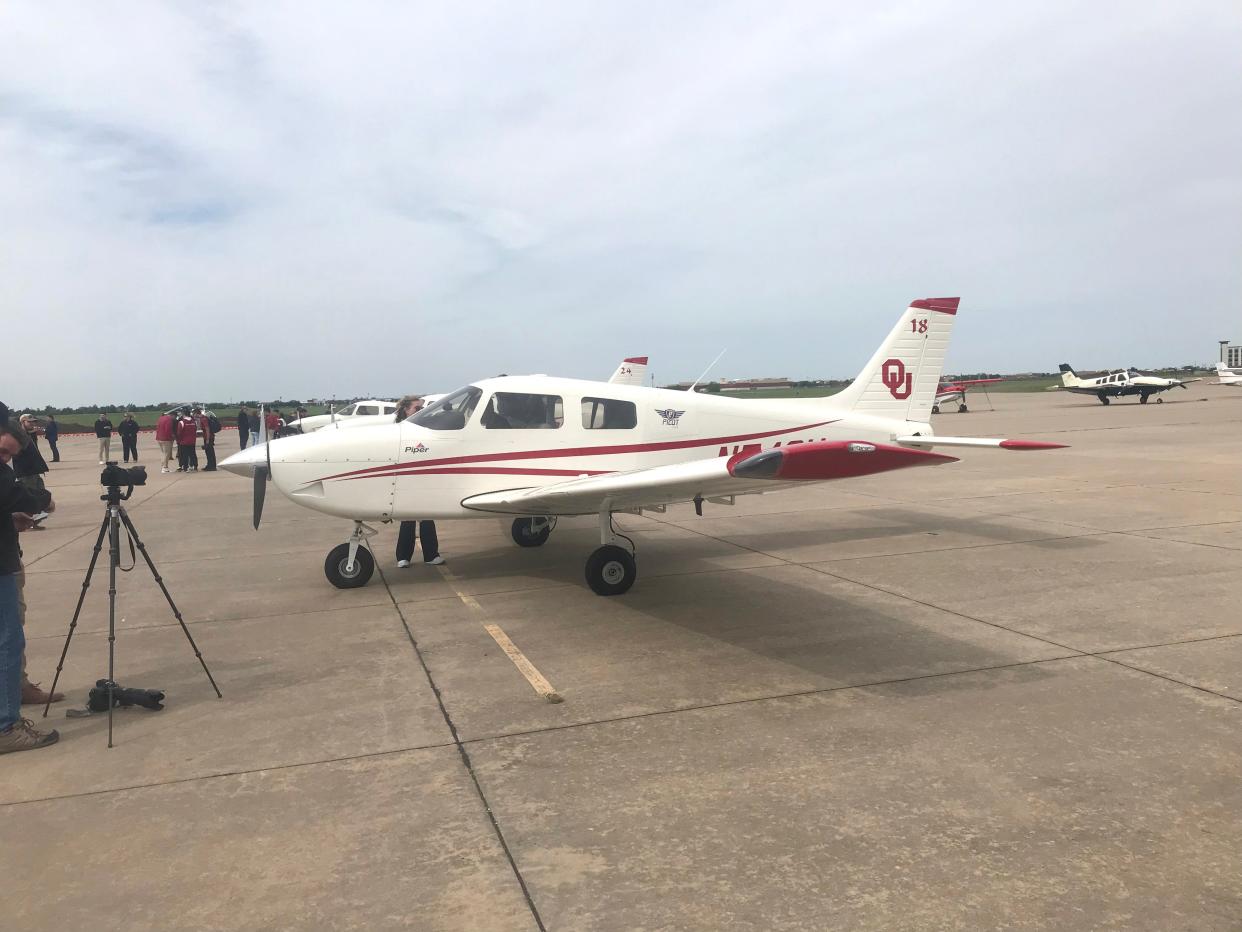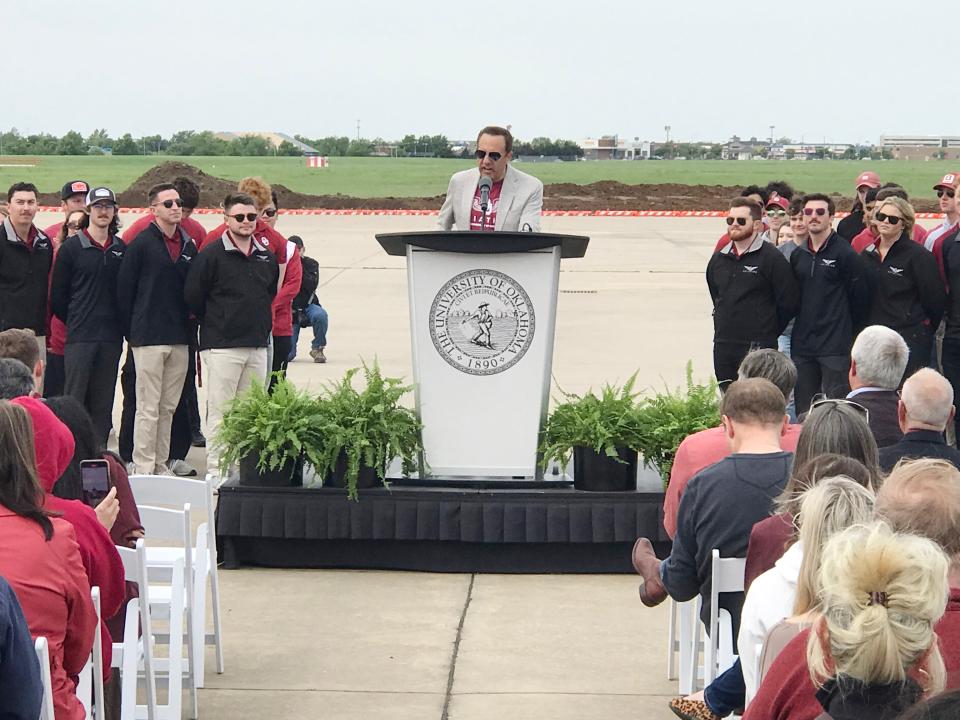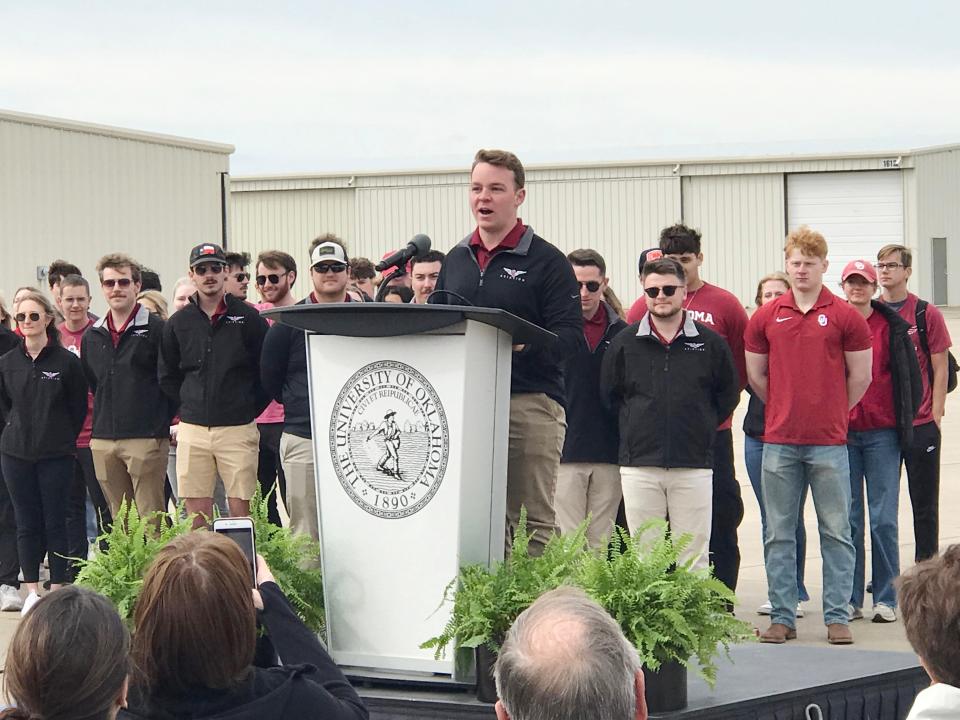OU is expanding its top-ranked aviation school with nine new aircraft, which just arrived

NORMAN — With music from the movie “Top Gun” blaring and its president decked out in aviator sunglasses and an “OU Aviation” T-shirt, nine airplanes bought by the University of Oklahoma for its top-ranked School of Aviation flew into Max Westheimer Airport on Friday morning.
The addition of the new Piper single-engine airplanes increases OU’s capacity for flight training, with a fleet of 28 planes now available, OU President Joseph Harroz said during an unveiling ceremony as the planes flew overhead.
OU public relations officials wouldn’t allow reporters to ask questions of Harroz following the event, such as how much the university spent on the aircraft. But the university previously announced a three-year, $10 million plan to replace its current fleet, which is aging. The nine aircraft that arrived Friday were delayed — they were supposed to have arrived this past December.
OU’s School of Aviation, established in 1947, operates out of the university-owned airport. The school already has 15 Piper Warrior III aircraft, one Cessna 152 Aerobat plane, two Twin Engine Piper Seminole planes and one King Air C-90 B Turbo Prop plane. In 2022, Flying magazine credited OU as having the best aviation college nationwide.

“What do you do when you’re number one? You double down,” Harroz told supporters gathered on the airport tarmac. “We committed to not just celebrate (being) first in the country, not just replacing our fleet, but doubling it and doubling the spots we have in our program. We know that being number one comes with not just the benefit of the talking points, but the obligation of service.”
OU is investing millions of dollars in its aviation program. In 2022, OU said it planned to more than double its enrollment in the School of Aviation from 250 to as many as 600 over a four-year span.
In January, university regents approved a $5 million budget to build a new hangar and update utility infrastructure at the airport. Construction has started on the hangar, which will be 10,000 square feet. The project also will include utility infrastructure capable of supporting future hangar development nearby.
In March, U.S. Rep. Tom Cole, R-Moore, announced he had secured $36.5 million in federal appropriations to support improvements at Westheimer Airport that include extending and strengthening the runway, developing a new taxiway and additional hangar space, and creating safer ingress and egress passageways. Cole called the airport “an essential part of the local economy.”
Also last month, OU regents approved a professional pilot-helicopter track option for its bachelor of science in professional studies degree program. Two helicopters previously purchased by the university for use in its fixed-wing helicopter aviation program also were displayed during Friday’s ceremony. Enrollment for that program is expected to begin this fall.
OU also is working with Norman Public Schools in the development of the Oklahoma Aviation Academy, an aviation immersion high school that also is located at Westheimer Airport.
Expansion aims to help fill need for aviation workers in Oklahoma
The aviation and aeronautics industry has about 120,000 employees and a $44 billion economic impact annually on the state, said Grayson Ardies, the executive director of the Oklahoma Department of Aerospace and Aeronautics. Oklahoma has numerous large aviation-related employers including Tinker Air Force Base, Vance Air Force Base in Enid, Altus Air Force Base, the American Airlines maintenance facility in Tulsa, the Federal Aviation Administration Academy in Oklahoma City, Boeing and others.
State Sen. Mary Boren, D-Norman ― whose district includes OU — attended Friday's ceremony and said the state is investing heavily in aviation to help meet those workforce needs. She's supportive of OU's role in that effort.
“Our budget is heavy in aviation,” Boren said. “We’ve got two or three tax credits around aviation going on right now. At the state level, they’re treating aviation as the next big industry in Oklahoma. If you think about it, with Enid, Altus and Tinker, when you have that many Air Force bases, then it’s just natural that you’re going to have this overlap with the private industry and the employment workforce development piece. They go together.”
During his remarks, Harroz said the new airplanes come equipped with modern avionics, such as moving map GPS and a glass cockpit, and are certified for flying under visual and instrument flight rating. They also have automated engine and systems management, an autopilot system and more powerful and fuel-efficient engines than the other airplanes in OU’s fleet.

The new planes will allow for better experiences for students because they are technically advanced, said Ben Arnold, a senior from Flower Mound, Texas, who is a certified flight instructor with a goal to become a professional pilot.
“I’m super excited, because the amount of training we’re going to be able to do now, with that many students that we’re adding on, it’s just going to be amazing to fly more and have more capacity in training,” Arnold told The Oklahoman. “We’ll have the newest fleet (compared) to other schools.”
Arnold said the planes “can fly 15 to 20 knots faster, then they can climb up a few thousand more feet. At higher altitudes, you’re more efficient with fuel. You might be able to get better wind direction or speed so you can fly more efficiently, and with greater speed, you can go farther distances.”
This article originally appeared on Oklahoman: OU celebrates arrival of new planes for its top-ranked aviation school

